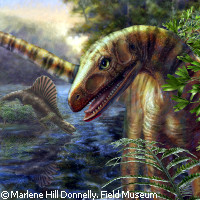Born again: dinosaurs 10 million years older?
A team of US and European palaeontologists has discovered the fossils of a creature which they believe lived 10 million years before the earliest known dinosaurs. The findings, published in the journal Nature, give weight to the theory that dinosaurs and other close relatives, such as pterosaurs (flying reptiles), may have lived much earlier than previously believed. This is the first discovery of a dinosaur-like creature in Africa by scientists investigating the Triassic Period (between 250 million and 200 million years ago). The species in question - called Asilisaurus kongwe - was related to the dinosaurs and shared many of their characteristics, but was not completely part of the dinosaur family. The animal's relationship to dinosaurs is similar to that of chimps and human beings. The oldest dinosaurs we know of are 230 million years old, and the discovery of their Asilisaurus ancestor 10 million years earlier suggests that the dinosaur lineage had already diverged 240 million years ago. The fossils of the Asilisaurus kongwe species were found in southern Tanzania, Africa. In the same fossil bed, the researchers also found the remains of primitive crocodiles, suggesting that the diversification of the relatives of crocodiles and birds was swift and occurred much sooner than initially believed by palaeontologists. Fossils of 14 of the species were extracted from the Tanzanian fossil bed allowing the palaeontologists to construct a nearly complete skeleton. The reconstruction showed that the creatures were 0.5 to 1 metre tall, 1 to 3 metres long and weighed 10 to 30 kg. They walked on four legs and probably lived on plants or plants and meat. The triangular teeth and beak-like tip of the creature's lower jaw suggests that they could have been both omnivores and herbivores. These skeletal traits evolved independently in at least two dinosaur lineages in species that were originally meat eaters, suggesting that possibly converting to a plant as well as meat diet gave them a wider habitat to live in and therefore an evolutionary advantage. The research also hints that this has happened at least 3 times in the evolution of dinosaurs and their close relatives in the space of less than 10 million years. 'Everyone loves dinosaurs,' said Professor Sterling Nesbitt of the University of Texas Austin in the US. 'But this new evidence suggests that they were really only one of several large and distinct groups of animals that exploded in diversity in the Triassic Period, including silesaurs, pterosaurs and several groups of crocodilian relatives. 'This goes to shows that there are whole groups of animals out there that we've never even found evidence of that were very abundant during the Triassic Period,' he added. 'It's exciting because it means there is still so much chance for discovery.' The research team included the Lamont-Doherty Earth Observatory at Columbia University in the US, the American Museum of Natural History and the Museum für Naturkunde in Berlin, Germany.
Countries
Germany, United States



